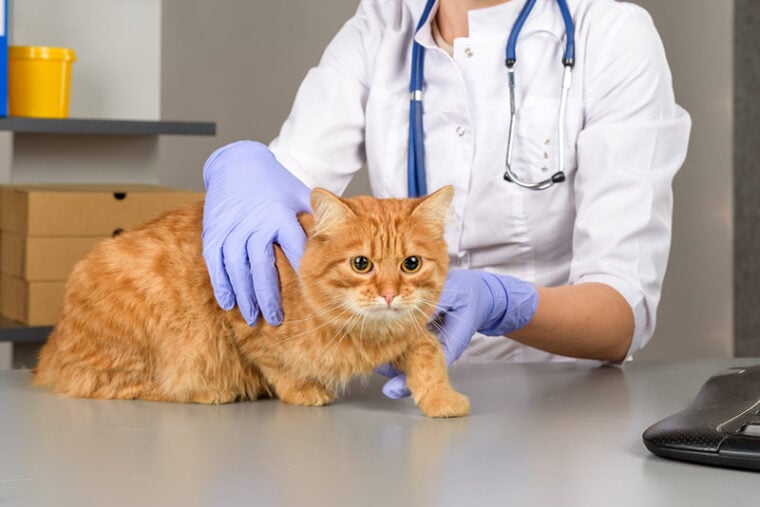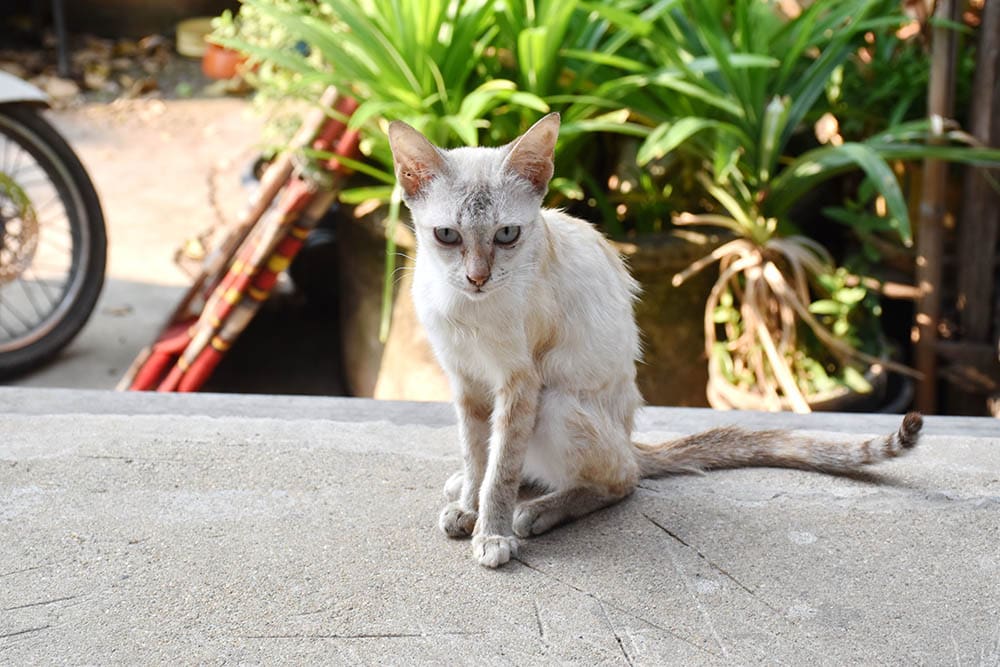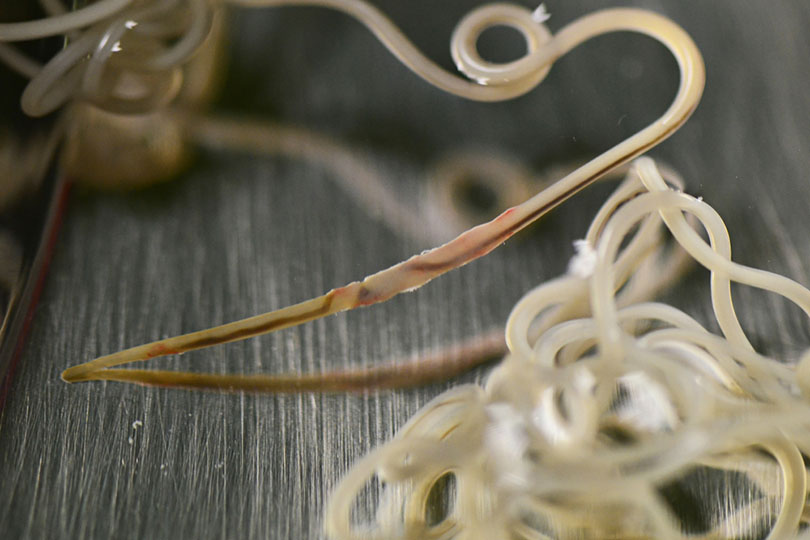
Click to Skip Ahead
Internal parasites can cause quiet infections in our cats, as the worms are often not visible, and clinical signs may be nonspecific. As a result, routine screening for these parasites is recommended. Means of infection, clinical signs, and treatment protocols vary depending on the parasite. An added “ick” factor is that some worms can cause illness in people, too! Keep reading below to learn more about the four most common parasitic worms in cats!
The 4 Common Types of Worms in Cats
1. Roundworms
Toxocara cati, and Toxacaris leonina are the two most common types of roundworms impacting cats. The worms are white in color and can grow to be up to 7 inches long. Differentiating between species is dependent on the appearance of the egg. Toxacaris leonina can infect dogs and cats, whereas adult Toxocara cati infections only occur in cats.

Life Cycle
The adult worms mate within the gastrointestinal tract and produce eggs. The eggs are then released into the environment when the cat defecates. It is important to note that fresh feces are not infective, and eggs must remain outside of the host for the larval stage to develop within the egg. After the larva has formed within the egg, the egg can be infective once ingested.
Once within the gastrointestinal tract, the larva breaks out of the egg. In cats, Toxacara cati larva will migrate out of the intestines into the lungs, liver, or other nearby tissue. Larva that reaches the lungs can cause havoc on the respiratory system, causing things like pneumonia. When a cat coughs, the larva is launched into the mouth and then swallowed, making its way back into the gastrointestinal tract. Once there, the larva matures into an adult worm, mates, and produces eggs to continue the life cycle.
If a Toxocara cati roundworm is eaten by another animal, the adult worm doesn’t develop. Instead, the larva migrates and encysts into tissue. If a cat consumes this animal, like a mouse, the cat can then become infected by eating the encysted larva.
Toxacaris leonina’s life cycle is less complex, and the larva doesn’t migrate from the gastrointestinal tract once initially ingested.
Clinical Signs
Cats with roundworm infections may experience vomiting, diarrhea, and reduced appetite. Early in infection, cats infected with Toxocara cati may experience a cough or pneumonia while the larva travel through the tissues and settle within the lungs. If the worm burden is large, occasionally gastrointestinal blockages may occur. A “pot bellied” appearance is used to describe the bloated appearance of an animal infected with gastrointestinal worms.

Diagnosis/Treatment
Roundworm infections are diagnosed with routine fecal tests. Fortunately, roundworms can be treated with routine dewormers and heartworm preventatives. When appropriate treatment is administered, the dead and dying worms may be seen in the stool or in vomit.
Important Notes
Roundworms do have zoonotic potential, meaning they can infect people. Roundworms are a leading cause of blindness in young children. Good hygiene and appropriate cleaning are necessary to prevent infection in humans.
2. Tapeworms
There are two main types of tapeworms that can infect cats: Dipylidium caninum and Taenia species. Dipylidium caninum is more common than Taenia, but both will be discussed. Tapeworms tend to be long, white worms that appear flat, different from the appearance of roundworms.

Life Cycle
Dipylidium caninum species infect cats and dogs through the ingestion of an infected flea, whether through grooming or through predation of flea-infested prey. The tapeworm egg first needs to be consumed by flea larvae. Once inside the flea larva, the egg matures as the flea larva develops into the adult flea. Once the infected flea is ingested by the cat, the tapeworm egg is released and hatches into the intestines. Once within the intestines, the worm continues to develop and absorbs nutrients from the host.
Alternatively, Taenia species cause infection when a prey animal is hunted and eaten by a cat. With this type of infection, an intermediate host, the prey animal, consumes a tapeworm egg, which then hatches and forms a sac. This is infectious to a cat when the prey animal is killed, and the sac is consumed. From there, the life cycle mirrors that of Dipylidium caninum.
In both types of tapeworms, the mature tapeworm within the intestine releases body segments containing eggs. These segments, called proglottids, are often seen stuck to the rectum of cats and resemble grains of rice. Proglottids will release eggs when opened, and the life cycle will be continued if consumed by the right species of animal.
Clinical Signs
Although unsettling, tapeworm infections are generally gentle on the host, without the development of clinical signs. With significant infections, weight loss may be seen. Proglottid segments adhered to the rectum, feces, or bedding of infected cats often alert owners and veterinarians to infection.

Diagnosis/Treatment
Infections can be difficult to recognize, as eggs are not routinely seen in routine fecal tests. Diagnosis often occurs through the identification of tapeworm segments. Tapeworms are generally very susceptible to praziquantel or fenbendazole. Your veterinarian will provide the most appropriate deworming protocol depending on the parasite.
Important Notes
Other types of tapeworms can also impact cats, including Echinococcus multilocularis. Tapeworm infections can impact people as well, but Echinococcus infections tend to be the most likely secondary to ingestion of infected meat.
3. Heartworms
Heartworm infections are commonly discussed in dogs; however, they can cause illness in cats as well. Heartworm infections are diagnosed less frequently in cats, as it is not routinely screened for in healthy cats and felines tend to have a lower worm burden, making diagnosis more complicated. Some cats are able to eliminate heartworm infections through their own immune system response. It is important to note that even indoor cats are at risk for heartworm infections.

Life Cycle
Cats become infected with heartworms when they are bitten by infected mosquitoes carrying early larval stages. The larva are transferred from the mosquito to the cat and travel through different tissues before making their way into the pulmonary arteries. The cat’s immune system is prepared to quickly destroy heartworm larva, so only about 25% of larvae reach adulthood.
When the cat’s body attacks the immature parasite, inflammation ensues, leading to a condition called HARD or Heartworm Associated Respiratory Disease. HARD results in labored breathing, collapse, coughing, wheezing, and, in some cases, death. Only a small portion of immature worms will reach maturity in the pulmonary artery.
Due to the low worm burden found in cats of typically 1–3 worms, single sex infections are common, meaning that heartworm reproduction is unlikely to occur. If microfilaria (baby heartworms) are produced, they are quickly destroyed by the cat’s immune system. Mature worms can lead to heart failure in the cat due to changes in the vasculature and heart, and alternatively, adult worms that die also present a significant health risk to the cat due to the inflammatory response it stimulates.
Clinical Signs
Signs of infection can vary but can include cough, labored breathing, vomiting, reduced appetite, and sudden death.

Diagnosis/Treatment
Heartworms can be difficult to identify in cats due to low worm burdens. Your veterinarian will likely recommend a few different tests to screen your cat if a heartworm infection is suspected. Unfortunately, there is no treatment for heartworm disease in cats, which emphasizes the necessity of prevention. Cats experiencing signs of heartworm disease may benefit from the use of steroids to help reduce inflammation and diuretics if signs of heart failure have developed.
Important Notes
Heartworm preventative is necessary to prevent infection in cats. Heartworms cannot be passed directly from pet to pet, as their lifecycle requires the mosquito as a host. The prognosis of cats experiencing heartworm-associated clinical signs is poor.
4. Hookworms
The most common species of hookworms impacting cats are Ancylostoma tubaeforme and Ancylostoma braziliense. These parasites are less than 1 inch long and latch onto the intestines using their hook-like mouth pieces to ingest host blood.

Lifecycle
Hookworm eggs are passed in the stool and deposited into the environment. The infective larvae hatch from the egg and spend time in the dirt until picked up by a cat. Cats can ingest the infected larva, typically through grooming; however, the parasite can also burrow through the skin. Alternatively, an insect or another prey animal may ingest the larva and pass the larva to the cat if eaten. Once ingested, the larva settles in the intestines where it continues to develop.
Occasionally, the hookworms will migrate through the skin, enter the trachea, and are coughed up and swallowed, gaining access to the gastrointestinal tract. The hookworm uses their mouth to attach the intestinal lining of the host’s intestines and then mate and reproduce eggs once fully mature.
Clinical Signs
Signs of infection can include abdominal distension, diarrhea, vomiting, poor coat quality, and weight loss. Cats can also develop anemia secondary to the bleeding that occurs due to parasite attachment and feeding. Blood or digested blood may be seen in the stool. Occasionally, lesions can be seen on the skin from the parasite burrowing.
Diagnosis/Treatment
Hookworm infections are easily diagnosed through the identification of eggs in routine fecal examinations. Hookworm infections are easily treated with routine dewormers, although two treatments are recommended and administered 2 weeks apart.
Important Notes
Hookworms do present a zoonotic potential, as the infective larval stage can burrow into the skin causing cutaneous larval migrans. Removing stool from the yard and litterbox promptly and utilizing good hygiene after handling feces reduces the risk of infection to people and other animals.
In Summary
Parasitic worms present a risk to our companion cats, even those kept strictly indoors! Appropriate preventative care like monthly heartworm, flea, and tick medications are helpful tools in minimizing the chances of infection. Owners should seek veterinary care if they are suspicious that their companion cat may be battling parasitic infections and to perform routine diagnostic tests that may pick up on quiet infections that may otherwise go undiagnosed.
Featured Image Credit: M. Arkhipov, Shutterstock






